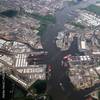Official U.S. Navy file photo of father of the U.S. Navy, John Paul Jones' tomb at the U.S. Naval Academy. Jones is forever immortalized by uttering the words, "I have not yet begun to fight", during the battle between his ship Bonhomme Richard and HMS Serapis, off the coast of England in 1779. The Naval Historical Center and other researchers are planning an expedition to try to find the wreck of Bonhomme Richard in the Summer of 2006.
The Naval Historical Center (NHC) announced in October it is joining the Ocean Technology Foundation (OTF) in spearheading an expedition in the summer of 2006 to search for the remains of American Revolutionary War naval hero John Paul Jones’ ship Bonhomme Richard.
“Finding Jones’ ship will vividly bring to life an inspiring chapter in America’s past using ocean technologies that are vital to America’s future,” said Dr. Sylvia Earle, a member of OTF’s board of directors.
Other project collaborators include the University of New Hampshire Center for Coastal Ocean Mapping/Joint Hydrographic Center, the College of Exploration, and English Heritage, which advises the British government on the historic environment.
One of the most memorable battles of the American Revolution took place off the coast of England Sept. 23, 1779, between the British ship HMS Serapis and Bonhomme Richard, captained by Jones. It was during this three-and-a-half-hour battle - most of it taking place at point blank range - that Jones shouted his legendary words, “I have not yet begun to fight,” in response to an offer to surrender. Ultimately, he emerged victorious and took control of Serapis, and 36 hours later watched his own ship sink into the North Sea.
"This expedition is a natural fit for OTF’s capabilities," said retired Capt. John Ringelberg, president of the OTF. “Our partners are the best and the brightest in their specific fields, and they form an exceptional team.”
One of the search team members, Peter Reaveley, is considered an expert on the battle between Bonhomme Richard and Serapis. Reaveley has spent more than 30 years compiling and analyzing eyewitness accounts, deriving the historical weather, wind and tidal data, and determining damages inflicted on the ship in the course of the battle. OTF has also created a computer model of the ship, which will simulate how it may have drifted after the battle. With the benefit of all this information, the project team has pinpointed an area where they believe the wreckage lies.
OTF and its partners will conduct surveys of the ocean floor using a magnetometer, which can detect large amounts of metal ballast underwater, and high-tech sonar systems that can identify anomalies on the ocean bottom. When found, the wreck of Bonhomme Richard will be one of the most important archeological discoveries in U.S. naval history.
“You cannot find a more important underwater archaeological site to the U.S. Navy than that of John Paul Jones' Bonhomme Richard. Discovery of the shipwreck will shed new light on the horrific battle between Bonhomme Richard and Serapis, what life was like on board Bonhomme Richard for the officers and crew, ship's armament and weaponry, and the construction of the ship itself,” said Dr. Robert Neyland, head of the NHC Underwater Archaeology Branch.
The Surface Navy Association is also a key supporter of the project.
"This is an initiative that we are proud to be involved in," Capt. Robert D. Jenkins III, member of the Surface Navy Association’s National Board of Directors said. "John Paul Jones and his crew set the standard for the future of surface warfare.”
An important component of the project will involve teachers, students and the public, who can share the search through the Internet. Lesson plans, an online workshop for teachers, and an interactive Web site will help raise awareness in the public and the education community of one of the most fierce and pivotal battles in U.S. naval history.
“Advances in science and technology have made it possible to find any ship that has been lost and buried in the seabed," said Neyland. "However, with the ability to discover comes also the responsibility to manage, preserve, and interpret for all."
From Naval Historical Center Public Affairs
Subscribe for
Maritime Reporter E-News
Maritime Reporter E-News is the maritime industry's largest circulation and most authoritative ENews Service, delivered to your Email five times per week










